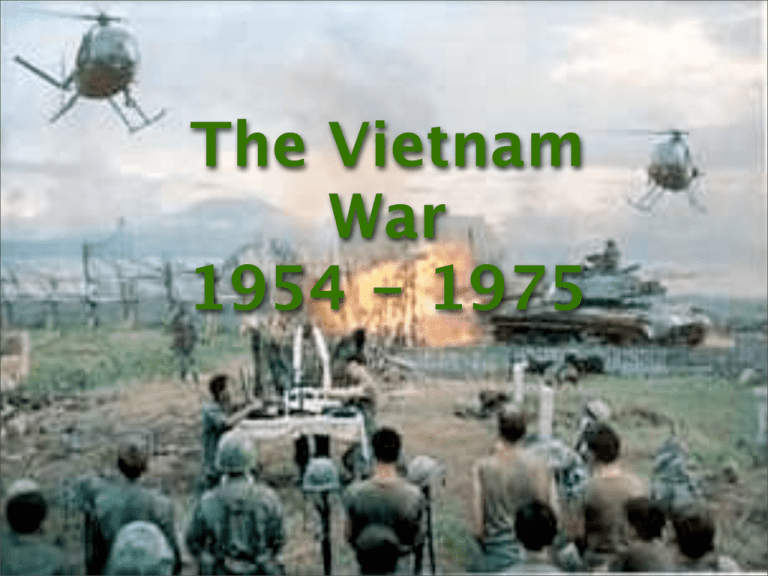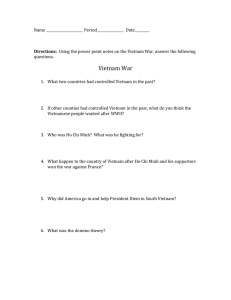The Vietnam War 1954 - 1975
advertisement

The Vietnam War 1954 - 1975 Background to the War z France controlled “Indochina” since the late 19th century z Japan took control during World War II z With U.S. aid, France attempted re-colonization in the postwar period Background to the War z The French lost control to Ho Chi Minh’s Viet Minh forces in 1954 at Dien Bien Phu z President Eisenhower declined to intervene on behalf of France. Background to the War z International Conference at Geneva P Vietnam was divided at 17th parallel O Ho Chi Minh’s nationalist forces controlled the North O Ngo Dinh Diem, a Frencheducated, Roman Catholic claimed control of the South Background to the War z A date was set for democratic elections to reunify Vietnam z Diem backed out of the elections, leading to military conflict between North and South Early Protests of Diem’s Government Self-Emolation by a Buddhist Monk U.S. Military Involvement Begins z Kennedy elected 1960 z Increases military “advisors” to 16,000 z 1963: JFK supports a coup d’etat – Diem and his brother are murdered (Nov. 2) Johnson Sends Ground Forces z Remembers Truman’s “loss” of China Domino Theory revived I’m not going to be the president who saw Southeast Asia go the way China went. Johnson Sends Ground Forces z Tonkin Gulf Incident 1964 (acc. to Johnson, the attacks were unprovoked) z Tonkin Gulf Resolution P “The Blank Check” * U.S. Troop Deployments The Ground War 1965-1968 z No territorial goals z Body counts on TV every night (first “living room” war) z Viet Cong supplies over the Ho Chi Minh Trail The Air War 1965-1968 z 1965: Sustained bombing of North Vietnam z Operation Rolling Thunder (March 2, 1965) z Downed Pilots: P.O.W.s z Carpet Bombing – napalm The Air War: A Napalm Attack Who Is the Enemy? z Vietcong: P Farmers by day; guerillas at night. P Very patient people willing to accept many casualties. P The US grossly underestimated their resolve and their The guerilla wins if he does not lose, the conventional army loses if it does not win. -- Mao Zedong Who Is the Enemy? The Tet Offensive, January 1968 z N. Vietnamese Army + Viet Cong attack South simultaneously (67,000 attack 100 cities, bases, and the US embassy in Saigon z U.S. + ARVN beat back the offensive z Viet Cong destroyed z BUT…it’s seen as an American defeat by the media The Tet Offensive, January 1968 Impact of the Tet Offensive z Domestic U.S. Reaction: Disbelief, Anger, Distrust of Johnson Administration z Hey, Hey LBJ! How many kids did you kill today? Johnson’s popularity dropped in 1968 from 48% to 36%. Impact of the Vietnam War Johnson announces (March, 1968): …I shall not seek, and I will not accept, the nomination of my party for another term as your President. American Morale Begins to Dip z Severe racial problems. z Major drug problems. Are We Becoming the Enemy? Charlie Company, 1st Battalion, 20th Infantry z Mylai Massacre, 1968 z 200-500 unarmed villagers z Lt. William Calley, Platoon Leader Anti-War Demonstrations Columbia University 1967 Hell no, we won’t go! Anti-War Demonstrations Student Protestors at Univ. of CA in Berkeley, 1968 Democratic Convention in Chicago, 1968 “Hanoi Jane” Jane Fonda: Traitor? Anti-War Demonstrations z May 4, 1970 z 4 students shot dead. z 11 students wounded Kent State University z Jackson State University z May 10, 1970 z 2 dead; 12 wounded Nixon on Vietnam z Vietnamization -slow withdrawl of troops z Agent Orange (chemical defoliant) “Pentagon Papers,” 1971 z Docs. Govt. misled Congress & Amer. People regarding its intentions in Vietnam during mid-1960s. P Primary reason for fighting not to eliminate communism, but to avoid humiliating defeat. The Ceasefire, 1973 z Peace is at hand Kissinger, 1972 P North Vietnam attacks South P Most Massive U.S. bombing commences z 1973: Ceasefire signed between P U.S., South Vietnam, & North Vietnam Peace Negotiations Dr. Henry Kissinger & Le Duc Tho z US & Vietnamese argue for 5 months over the size of the conference table! The Ceasefire, 1973 z Conditions: 1. U.S. to remove all troops 2. North Vietnam could leave troops already in S.V. z Last American troops left South Vietnam on March 29, 1973 z 1975: North Vietnam defeats South Vietnam z Saigon renamed Ho Chi Minh City The Fall of Saigon South Vietnamese Attempt to Flee the Country The Fall of Saigon April 30, 1975 America Abandons Its Embassy The Fall of Saigon North Vietnamese at the Presidential Palace A United Vietnam Formerly Saigon The Costs 1. 3,000,000 Vietnamese killed 2. 58,000 Americans killed; 300,000 wounded 3. Under-funding of Great Society programs 4. $150,000,000,000 in U.S. spending 5. U.S. morale, self-confidence, trust of government, decimated. The Impact z 26th Amendment: 18-year-olds vote z Nixon abolished the draft all-volunteer army z War Powers Act, 1973 P ٭ President must notify Congress within 48 hours of deploying military force z Disregard for Veterans seen as “baby killers” z POW/MIA issue lingered Some American POWs Returned from the “Hanoi Hilton” Senator John McCain (R-AZ) 2,583 American POWs / MIAs still unaccounted for today. And in the End…. Ho Chi Minh: If we have to fight, we will fight. You will kill ten of our men and we will kill one of yours, and in the end it will be you who tires of it. 58,000


![vietnam[1].](http://s2.studylib.net/store/data/005329784_1-42b2e9fc4f7c73463c31fd4de82c4fa3-300x300.png)
